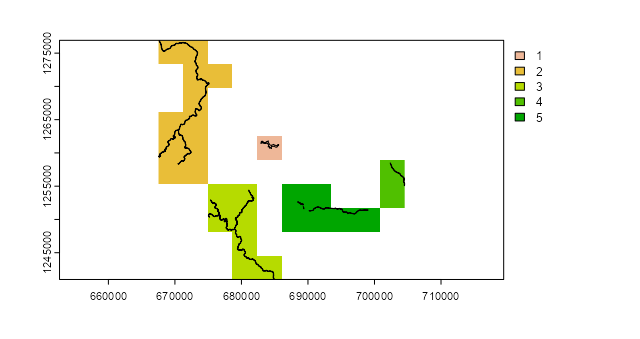I am currently struggling with rasterizing and later, resampling a vector object using functions from stars and terra.
Let's start with the example dataset here: https://drive.google.com/drive/u/2/folders/1uDVQt1F64rUTfCXclwr-sM-oFjyJ2NwV
This is a dataset of waterbodies and I load them first using sf
waterBodies_nil1870 <- st_read("data\spatial\waterBodies_nil1870.shp")
waterBodies_nil1870 <- st_transform(waterBodies_nil1870, 32643)
> waterBodies_nil1870
Simple feature collection with 5 features and 3 fields
Geometry type: MULTIPOLYGON
Dimension: XY
Bounding box: xmin: 667536.9 ymin: 1240976 xmax: 704538.2 ymax: 1276926
Projected CRS: WGS 84 / UTM zone 43N
id class gridcode geometry
1 1 waterbodies 1 MULTIPOLYGON (((683042.8 12...
2 2 waterbodies 1 MULTIPOLYGON (((669090.5 12...
3 3 waterbodies 1 MULTIPOLYGON (((675343.5 12...
4 4 waterbodies 1 MULTIPOLYGON (((702393.8 12...
5 5 waterbodies 1 MULTIPOLYGON (((688438.4 12...
Now I would like to rasterize this simple feature and resample it so that I further compute area statistics to compare with other rasters. To do so I have been struggling with using functions from both the stars and the terra package and each time, I believe I am losing values and data associated.
Let's start with functions from the stars package:
> new <- st_rasterize(waterBodies_nil1870)
> new
stars object with 2 dimensions and 2 attributes
attribute(s):
Min. 1st Qu. Median Mean 3rd Qu. Max. NA's
id 1 2 2 2.547945 3 5 64790
gridcode 1 1 1 1.000000 1 1 64790
dimension(s):
from to offset delta refsys point values x/y
x 1 259 667537 143.276 WGS 84 / UTM zone 43N FALSE NULL [x]
y 1 251 1276926 -143.276 WGS 84 / UTM zone 43N FALSE NULL [y]
In the above scenario, I have now lost the class attribute column and only id and gridcode are preserved for some reason. Notice that this error continues to surface even if I do: st_rasterize(waterBodies_nil1870["class"]).
Let's try functions from the terra package now:
v1 <- vect(waterBodies_nil1870)
> v1
class : SpatVector
geometry : polygons
dimensions : 5, 3 (geometries, attributes)
extent : 667536.9, 704538.2, 1240976, 1276926 (xmin, xmax, ymin, ymax)
coord. ref. : WGS 84 / UTM zone 43N (EPSG:32643)
names : id class gridcode
type : <num> <chr> <num>
values : 1 waterbodies 1
2 waterbodies 1
3 waterbodies 1
> r1 <- rast(v1)
> r1
class : SpatRaster
dimensions : 10, 10, 1 (nrow, ncol, nlyr)
resolution : 3700.129, 3595.036 (x, y)
extent : 667536.9, 704538.2, 1240976, 1276926 (xmin, xmax, ymin, ymax)
coord. ref. : WGS 84 / UTM zone 43N (EPSG:32643)
> hasValues(r1)
[1] FALSE
How do I rasterize a simple features object and then resample it using R?


